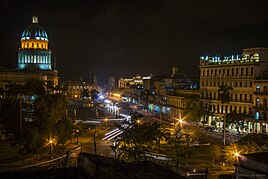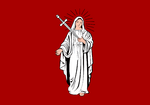Guaitiao
Guaitiao
El Guaitiao | |
|---|---|
Capital city and Province | |
Tablero at night El Primordial Passeo de la Taberna Saint Christina Cathedral Playa del Guarano | |
| Nickname: Faro del Sunádico (Lighthouse of the Sunadic) | |
| Motto(s): "Veni, vidi, vici" (Latin) "I came, I saw, I conquered" | |
| Country | |
| Province | Guaitiao |
| Established | 12 April 1511 |
| Founded by | Tomas de Santillana |
| Government | |
| • Body | Gobierno Municipal del Guaitiao |
| • Mayor | Juan Esteban Illescas (PCM) |
| Area | |
| • Total | 755.53 km2 (291.71 sq mi) |
| Elevation | 42 m (138 ft) |
| Population (2020) | |
| • Total | 3,150,567 |
| • Density | 4,200/km2 (11,000/sq mi) |
| Demonym | Guaitian |
| Time zone | UTC+3 (MST) |
| • Summer (DST) | UTC+4 (MSST) |
| HDI (2020) | 0.834 - very high |
| Website | www.elguaitiao.gov.lm |
Guaitiao (/ɡwaitiao/) is the capital and largest city of Montilla. The administrative centre of Guaitiao Province, Guaitiao is the country's main port and commercial center. It is one of the most populous and largest cities of Caliandia and the Sunadic Ocean.
The city was founded by Canterian explorer Tomas de Santillana in the early 16th century, serving as an outpost until it was granted the status of capital of the Viceroyalty of Caliandia in 1592 by the Canterian monarchy. It was protected by walls and forts, considered some of the most significant in the Sunadic.
The city is the seat of the Montillan government since 1812, housing the People's National Assembly, various ministries and foreign diplomatic offices. The mayor of Guaitiao is Juan Esteban Illescas (PCM) since 2016. In 2020, the city/province had the second-highest income in the country. The city receives millions of tourists each year, being noted as a place of cultural and historical significance. Guaitiao has a tropical climate.
Etymology
History
16th century
The expedition led by Canterian explorer and conquistador Tomas de Santillana first landed in the region they called first called "Punta de los Vientos" in 1506, where they first set up the settlement of Sagrada Voluntad de la Bahía as a base of operations to explore the rest of the island. In the immediate weeks and months following the creation of the settlement, settlers came into contact with the Guarano tribe of the Guaitiao, some of those encounters were violent, and led to a military expedition of 10 men led by Tomas de Santillana into the jungle. Facing the tribe with overwhelming force, the elders surrendered and agreed to negotiate. In what Canterians settlers called the Treaty of Sagrada Voluntad, the natives agreed to join the settlement under the condition they cease hostilities against the settlers, convert to Christianity, and learn the Canterian language. The effort to Christianize the natives led to the creation of the monastery of Santa Cristina del Guaitiao in 1509, and in 12 April 1511, Tomas de Santillana and theologian Juan de Alcala declared the foundation of the village of Santa Cristina de la Sagrada Voluntad del Guaitiao.
17th century
Government
Geography
Demography
Economy
Transport
Education
Landmarks and Historical Centres
Culture
Health









